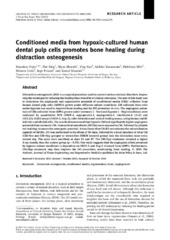| dc.description.abstract | Distraction osteogenesis (DO) is a surgical procedure used to correct various skeletal disorders. Improving the technique by reducing the healing time would be of clinical relevance. The aim of this study was to determine the angiogenic and regenerative potential of conditioned media (CMs) collected from human dental pulp cells (hDPCs) grown under different culture conditions. CM collected from cells under hypoxia was used to improve bone healing and the DO procedure in vivo. The angiogenic potentials of CMs collected from hDPCs grown under normoxic (−Nor) and hypoxic (−Hyp) conditions were evaluated by quantitative PCR (VEGF-A, angiopoietin-1, angiopoietin-2, interleukin-6 (IL-6) and CXCL12), ELISA assays (VEGF-A, Ang-2), tube-formation and wound-healing assays, using human umbilical vein endothelial cells. The results demonstrated that hypoxic CM had significantly higher angiogenic potential than normoxic CM. Human fetal osteoblasts (hFOBs) were exposed to CM, followed by alizarin red staining, to assess the osteogenic potential. It was found that CM did not enhance the mineralization capacity of hFOBs. DO was performed in the tibiae of 30 mice, followed by a local injection of 20 µl CM (CM–Nor and CM–Hyp groups) or serum-free DMEM (control group) into the distraction zone every second day. The mice were sacrificed at days 13 and 27. The CM–Hyp treatment revealed a higher X-ray density than the control group (p < 0.05). Our study suggests that the angiogenic effect promoted by hypoxic culture conditions is dependent on VEGF-A and Ang-2 released from hDPCs. Furthermore, CM–Hyp treatment may thus improve the DO procedure, accelerating bone healing. © 2015 The Authors. Journal of Tissue Engineering and Regenerative Medicine published by John Wiley & Sons, Ltd. | en_US |

